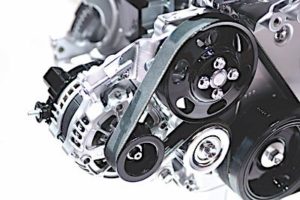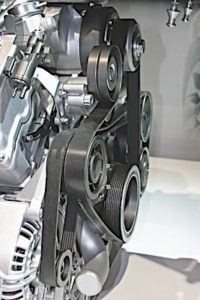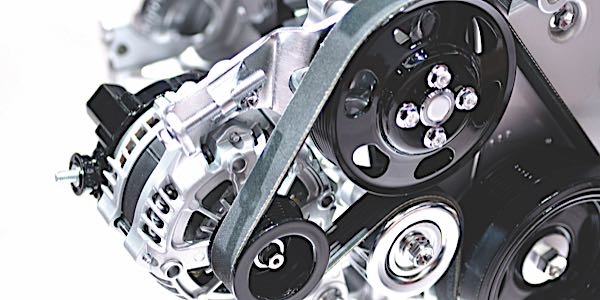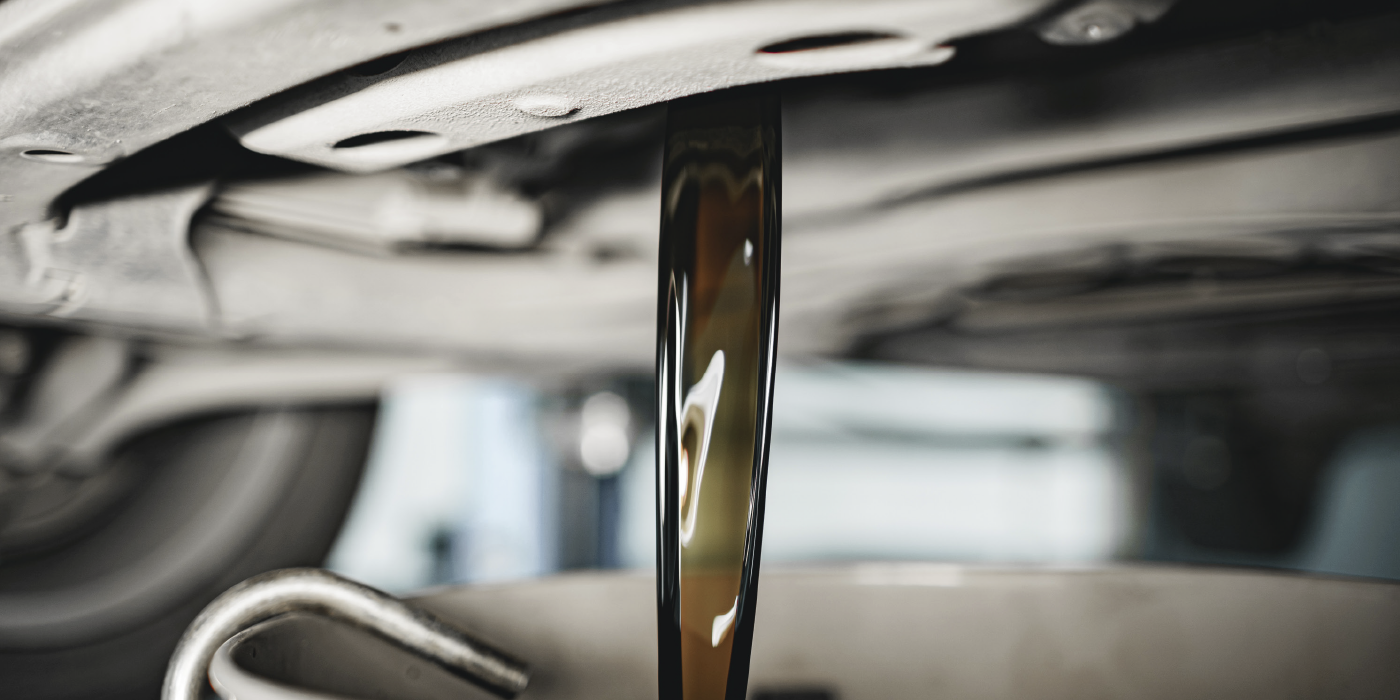Most late-model engines have serpentine belt drives for the engine-driven accessories, and most people know that belts are a maintenance item that eventually has to be replaced. However, many people don’t know the spring-loaded automatic tensioner that keeps a serpentine belt tight is also a wear item. Consequently, the automatic tensioner may also have to be replaced when the time comes to change the belt.
The automatic tensioner has a coil spring inside that applies just the right amount of force against the belt to keep it tight. The tensioner also provides a little “give” so it can absorb and cushion shock loads on the belt that occur when the A/C compressor clutch cycles on and off. What’s more, the tensioner automatically compensates for wear and keeps the belt under constant tension. But, nothing lasts forever — and that includes belts and automatic tensioners.

If an aging belt is not replaced, it may break, causing a loss of drive torque to all of the engine’s accessories. When the water pump stops turning, the flow of coolant also stops and the engine begins to overheat. When the alternator stops turning, there is no charging output and the battery starts to run down. When the power steering pump stops turning, the steering suddenly gets very stiff and hard to control.
All too often, an old or a broken serpentine belt will be replaced with a new one, but the automatic tensioner is not inspected to make sure it is still working properly and in good condition. This mistake can lead to rapid belt wear and repeat belt failures if the tensioner is weak or worn out.
Belt tension is critical. Too little tension may allow the belt to slip and squeal. Slippage also causes the belt to run hot and age prematurely. If the belt is really loose, it may come off of its pulleys. Too much tension on a belt may overload it as well as the shaft bearings on the water pump, alternator, power steering pump and air conditioning compressor, possibly leading to premature failures in these components.
Belt tensioners were first used back in the late 1970s. These early units were fixed tensioners that required manual adjustment. Then, automatic belt tensioners arrived in the mid-1980s. The spring-loaded design eliminated the need for manual adjustments and assured proper belt tension for the life of the belt. Because of this, the tensioner is often overlooked when a belt is replaced. Even so, the tensioner should always be inspected when changing a belt because:
• Rust or corrosion can jam the tensioner housing and prevent it from rotating freely. A frozen tensioner cannot maintain proper belt tension. Corrosion is usually a result of road splash, especially in areas where roads are heavily salted during the winter.
• Dirt or mud can also jam the tensioner housing.
• A loose or worn pivot arm can allow unwanted movement that results in belt noise and misalignment. Over time, this will increase belt wear and lead to premature belt failure.
• A worn bushing in the tensioner pulley can cause vibrations and noise. If the bushing seizes, it may cause the belt to snap.
• A weak or broken spring inside the tensioner can’t maintain proper tension and the belt will slip. Springs lose tension over time from exposure to heat.
• Cracks or damage to the tensioner housing or pulley arm may prevent it from rotating smoothly and maintaining proper belt tension.
Tensioner Checks
Check the movement of the tensioner arm with the engine off. Use a socket with a long handle ratchet or breaker bar on the tensioner pulley center bolt to rotate the tensioner. There are no specifications for measuring the amount of resistance offered by the tensioner spring, but if the tensioner offers little resistance, it may indicate a weak or broken spring. If it fails to move at all, the tensioner is jammed and needs to be replaced.
Watch for looseness in the arm when the tensioner is rotated. The arm should not wobble or twist. If it does, the tensioner bearings are worn and the unit needs to be replaced.

Also note the position of the arm on the automatic tensioner. Many units have marks on the housing that show the normal range in which the arm can pivot. If the position of the arm is outside these marks, it indicates a problem (the belt may be too long or too short, or the tensioner may be jammed).
Note the wear pattern on the tensioner and idler pulley(s). Misalignment and bearing wear can cause the belt to track off-center and will cause it to wear quickly. Check the tensioner and idler pulley bearings by removing the belt and spinning the pulleys by hand. All pulleys should turn freely with no binding, roughness or wobble. Any binding, roughness or wobble means these parts are bad and need to be replaced.
Pulley alignment should also be checked to make sure there isn’t a mounting problem in the belt-drive system. It can be checked by placing a straight edge against the pulleys or with a special laser alignment tool designed for this purpose.
Replacement Tips
If the automatic belt tensioner has failed (and the engine has a lot of miles on it), it’s probably a good idea to replace the idler pulley(s) at the same time. Why? Because the shaft bearings on all the pulleys will have the same amount of wear. If they are reaching the end of their service life, replacing them now will restore the pulleys to like-new condition and reduce the risk of a breakdown because of a belt or pulley failure.
A special tool may be needed when replacing a serpentine belt or automatic tensioner on a transverse-mounted engine in a FWD vehicle. The tool has a long, flat extension handle that allows a socket to be placed on the tensioner bolt or flats on the tensioner arm.
Decoupler Pulleys
Some alternators have a decoupler pulley. This device serves two purposes. First, it helps to decouple the pulley from the alternator with a one-way clutch. The decoupler reduces parasitic losses by not having to fight against the momentum of the armature alternator while the engine is decelerating and accelerating. Some decoupler pulleys have a spring and friction dampener to reduce vibration. When an alternator decoupler pulley is compromised, it can no longer absorb the same level of abuse, which has a trickle-down effect throughout the system.
Alternator decouplers and pulleys should be inspected every 10,000 miles for wear. Early design versions have a service life of 40,000 to 60,000 miles, with more recent versions lasting more than 100,000 miles.
When inspecting a decoupler or pulley, there are two signs that replacement is needed. First, after shutting down the engine, if there is an audible buzzing, the bearings in the pulley have likely failed. The second sign depends on whether the vehicle has a one-way clutch (OWC), overrunning alternator pulley (OAP) or decoupler (OAD).
With the inspection cap/cover removed and the center locked, turn the pulley or decoupler with the appropriate tool. If it is an OAP or OWC, the pulley can be turned only in the clockwise direction. If it is an OAD, a counterclockwise turn will reveal a noticeable increase in spring force; a clockwise turn will have only slight resistance.
The tensioner, harmonic balancer and decoupler pulley work together to keep the belt in contact with grooves in the pulleys. The three components are engineered together to match the engine. If one part is compromised, all of them are compromised, including the belt.














